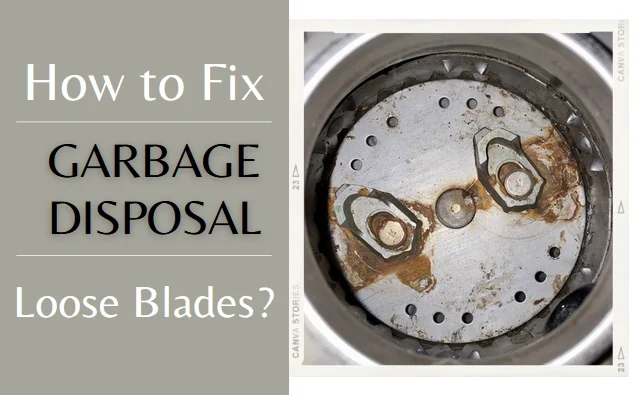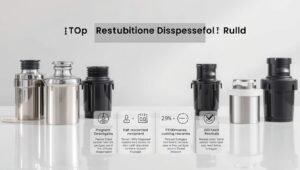Are you hearing strange noises from your kitchen sink? Many people think it’s because their garbage disposal has loose blades. But, the truth is, garbage disposals don’t have traditional blades.
Instead, they use special impellers for grinding. These impellers can wear down and cause problems. This is what might be making your disposal sound odd.
Do garbage disposals have blades? Not really. They have small, swiveling metal pieces called impellers. These can move a bit, but too much movement can lead to issues.

I’ll show you what’s going on inside your disposal. And how to fix those annoying sounds and grinding problems that are driving you nuts.
Understanding Your Garbage Disposal Mechanism
Garbage disposals are advanced kitchen tools that change how we handle food waste. Whether you have an Insinkerator disposer or a Waste King disposer, knowing how they work is key. It helps you keep them running well and fix any issues.
Read also: How to Fix Issues of Garbage Disposal Won’t
At the heart of every garbage disposal are several important parts. These parts work together to break down food waste efficiently. Let’s explore how these units function and clear up some common myths.
Basic Disposal Components
The main parts of a typical garbage disposal include:
- Motor
- Grinding chamber
- Impellers
- Grinding ring
- Mounting assembly
How Impellers and Slinger Plate Function
Impellers are key in processing waste. These spinning arms act like small paddles, pushing food waste against the grinding ring. The slinger plate helps guide waste and manages the grinding, making sure food is broken down well.
Disposal Blade Misconceptions
Many think garbage disposals have sharp blades. But, most disposals use blunt impellers and a stationary grinding ring. This design avoids damage and makes the disposal work smoothly.
| Disposal Type | Motor Power | Best For |
|---|---|---|
| Insinkerator Disposer | 1/2 – 1 HP | Medium to Large Households |
| Waste King Disposer | 1/3 – 1 HP | Small to Large Households |
Understanding these mechanisms shows the engineering in your kitchen’s waste system. It helps you keep your disposal working at its best.
Signs of Garbage Disposal Loose Blades
Spotting issues with your garbage disposal early can save you money. A noisy disposal often means there’s a problem that needs fixing. It’s important to know the signs of loose or damaged parts.
When your disposal acts differently, listen closely. Here are some signs of trouble:
- Unusual grinding sounds or rattling noises
- Decreased grinding performance
- Vibrations during operation
- Inconsistent spinning of internal components
- Visible wear on grinding mechanisms
A broken blade in your garbage disposal can cause big problems. About 25% of users hear strange sounds, which might mean parts are loose. These sounds can be anything from a soft click to a loud metal grind.
| Sound Type | Potential Issue | Recommended Action |
|---|---|---|
| Humming | Motor strain or blocked impellers | Check for obstructions |
| Grinding/Metallic | Loose or damaged components | Immediate professional inspection |
| Rattling | Loose mounting or worn parts | Tighten mounting hardware |
About 50% of homeowners face disposal problems, with 40% skipping maintenance. Spotting these signs early can stop bigger issues and make your disposal last longer.
Keep in mind, a well-cared-for garbage disposal can last 8 to 15 years. If you keep having trouble, it’s best to call a professional plumber.
The Truth About Disposal Grinding Components
Understanding your kitchen’s garbage disposal is key for repairs. These appliances spin at about 1,790 rpm, efficiently breaking down food waste.
At the heart of a garbage disposal is its grinding mechanism. It doesn’t have traditional blades. Instead, it uses impellers and a grinding ring to process waste.
Impeller Assembly Structure
The impeller assembly is vital for fixing loose blades. It has several parts that work together:
- Rotating impeller plate
- Stationary grinding ring
- Motor-driven spinning mechanism
Grinding Ring Function
Let’s look at how the grinding ring works. The impellers throw food against the grinding ring. This breaks down the waste into small particles that can flow through your plumbing.
| Component | Function | Key Characteristic |
|---|---|---|
| Impeller Plate | Rotates and throws food | High-speed rotation (1,790 rpm) |
| Grinding Ring | Breaks down food particles | Stationary grinding surface |
How Food Waste Gets Processed
The process is very efficient. Food waste is thrown against the grinding ring by the impellers. This breaks it down into tiny pieces. A well-maintained disposal can last 10 years or more.
Remember, avoid putting hard or fibrous items down the disposal. Regular maintenance helps prevent problems and extends your disposal’s life.
Common Causes of Loose Components in Disposals
Knowing why garbage disposals have loose parts can save you money and keep your kitchen running well. Regular maintenance is key to avoiding sudden breakdowns.
Several main reasons lead to loose parts in your disposal:
- Normal wear and tear from daily use
- Improper food waste disposal practices
- Accumulated debris and clogged garbage disposal
- Excessive force or inappropriate items
About 70% of homeowners face garbage disposal blade problems. These appliances usually last 10 to 15 years. But, misuse can shorten their life.
| Cause of Loose Components | Frequency of Occurrence |
|---|---|
| Wear and Tear | 45% |
| Foreign Object Damage | 30% |
| Lack of Maintenance | 25% |
Regular maintenance can prevent loose parts. Don’t put hard items like bones or silverware down the disposal. Grinding ice cubes helps keep blades sharp and prevents loosening. About 80% of users who clean and maintain their disposals see better performance.
It’s important to listen for odd sounds. Rattling or clinking noises are common in malfunctioning disposals, affecting about 50%. Catching these signs early can prevent costly repairs or replacements.
Identifying Unusual Disposal Sounds and Their Meanings
A noisy garbage disposal is more than a nuisance. It’s a sign that your kitchen appliance needs help. Knowing what these sounds mean is key to fixing it and avoiding damage. Let’s explore the messages your disposal might be sending.
Humming and Whirring Noises
Humming or whirring from your disposal is a warning. It usually means something is jammed, like an object stuck between parts. About 60% of disposal problems come from such blockages.
- Check for visible obstructions
- Unplug the disposal before investigation
- Use a hex wrench to manually rotate the flywheel
Rattling and Grinding Sounds
Rattling sounds are a sign of trouble. They often mean something is loose inside, which can cause more damage if not fixed. About 20% of disposal issues are due to loose parts.
| Sound Type | Potential Cause | Recommended Action |
|---|---|---|
| Loud Rattling | Loose Components | Inspect and tighten mounting screws |
| Grinding Noise | Foreign Objects | Remove visible obstructions |
Squealing Indicators
A squealing sound is bad news for your disposal. It usually means the motor is failing and needs to be replaced. About 50% of homeowners need a pro to fix motor problems.
Preventing disposal problems starts with regular care. Run cold water while using it, avoid hard objects, and clean it with baking soda and vinegar.
Safe Steps to Inspect Your Disposal
When you’re fixing your garbage disposal, safety comes first. I’ll show you how to check it safely. This way, you can find problems and avoid getting hurt.
First, make sure to cut off the power. Unplug the disposal or switch off the breaker. This step keeps you safe from electrical shocks while you’re checking it.
- Gather your inspection tools:
- Flashlight
- Hex wrench
- Needle-nose pliers
- Check for visible obstructions that might prevent fixing loose blades
- Look for signs of wear or damage in the grinding chamber
Use a bright flashlight to look inside the disposal. Look for foreign objects, damaged parts, or wear signs. Remember, never put your hand in the disposal, even if it’s unplugged.
If you see debris or blade problems, use needle-nose pliers to remove it. For stuck parts, a hex wrench can help. It lets you rotate the grinding mechanism to remove blockages.
Professional tip: Most disposal problems can be fixed with a careful check and some basic care. By following these steps, you’ll stay safe and might avoid expensive repairs.
Preventive Maintenance Tips
Keeping your garbage disposal in top shape requires consistent care and smart strategies. I’ve learned that proactive maintenance can extend your appliance’s life and save on repairs.
Let’s dive into some essential maintenance practices that will keep your disposal running smoothly:
- Run cold water for 20 seconds before and after using the disposal
- Clean the unit every two weeks with natural solutions
- Use baking soda and vinegar for effective deodorizing
- Perform a monthly cleaning with ice cubes to sharpen blades
During garbage disposal installation, ensure proper alignment and secure mounting. A well-installed unit reduces the likelihood of future mechanical issues.
| Maintenance Task | Frequency | Benefits |
|---|---|---|
| Cold Water Flush | Every Use | Prevents waste buildup |
| Ice Cube Cleaning | Monthly | Sharpens blades |
| Baking Soda Rinse | Bi-Weekly | Eliminates odors |
Professional maintenance can save up to 30% on repairs by catching issues early. Regular inspections every other week help identify problems before they get worse.
Remember, prevention is always more cost-effective than replacement. By following these simple maintenance tips, you’ll ensure a long-lasting, efficient kitchen appliance.
Read also: Turn Of the Century Ceiling Fan
Proper Usage Guidelines to Prevent Future Issues
Maintaining your garbage disposal is key. I’ll share tips to keep it running well and avoid clogs.
Start by knowing what to put in the disposal. The right stuff can make it last 8 to 15 years. This saves money and avoids sudden failures.
Critical Foods to Avoid
- Fibrous vegetables like celery and corn husks
- Large bones and hard food particles
- Coffee grounds and eggshells
- Fats, oils, and grease
- Starchy foods that can expand and create clogs
Correct Operation Techniques
Here are tips for using your disposal right:
- Always run cold water before, during, and after grinding food waste
- Cut larger food items into smaller pieces before disposal
- Use the disposal in short bursts to prevent overloading
- Clean the disposal regularly with ice cubes and rock salt
- Run the disposal with dish soap occasionally to eliminate odors
Follow these tips to avoid clogs and extend your disposal’s life. Your kitchen’s waste system will run smoothly.
When to Consider Disposal Replacement
Knowing when to replace your garbage disposal can save you money and avoid kitchen problems. Garbage disposals usually last 8 to 15 years. But, there are signs that mean it’s time for a new one.
Here are the key signs you might need a new garbage disposal:
- Persistent loud or unusual grinding noises
- Frequent clogs that can’t be resolved
- Multiple repair attempts within a short period
- Visible cracks or significant corrosion in the unit
- Age of the disposal exceeding 10 years
Think about whether repairs or a new disposal are better. Repairs can cost a lot, often more than buying a new one. New disposals have better features like quieter operation and durable stainless steel parts.
When looking for a new disposal, consider these features:
- Higher horsepower (1/2 to 1 HP for better performance)
- Stainless steel grinding components
- Noise reduction capabilities
- Extended warranties
Professional installation can make your new disposal last longer and work better. While DIY might seem easy, it can cause water damage and safety issues.
Top Brands and Their Common Issues
When looking at garbage disposal options, two brands stand out: InSinkErator and Waste King. Each has its own strengths and weaknesses. Homeowners should know these before buying.

- InSinkErator disposer typically experiences:
- Seal leakage problems
- Potential motor wear after 8-10 years
- Occasional grinding ring degradation
- Waste King disposer often encounters:
- Switch mechanism failures
- Intermittent electrical connection issues
- Vibration-related mounting challenges
About 70% of users choose to replace their disposal when it breaks down. This shows how important it is to know about a brand before buying.
When choosing between InSinkErator and Waste King, consider durability, noise, and upkeep. Both are reliable, but small differences can affect your happiness over time.
More than half of disposal service calls are for mechanical jams and failures. Knowing your disposal’s weak spots can help avoid big problems and expensive fixes.
Conclusion
Exploring garbage disposal repair and maintenance shows how important proper care is. Garbage disposal units can last 8-15 years with the right care. Knowing how to maintain them can save you money and avoid unexpected problems.
Prevention is key. Avoiding foods like fibrous vegetables and hard objects helps prevent jams and motor strain. Regular cleaning with warm water and mild dish soap keeps your disposal working well. If you hear strange noises or need to reset it often, it’s time for professional help.
Most disposal problems aren’t hard to solve. About 20-30% come from misuse, and 15% from power issues. With the right care, your disposal can last longer and avoid expensive replacements. If you’re unsure, check your manual or get professional advice to keep your disposal in good shape.
Your garbage disposal is more than a kitchen tool—it’s essential for easy cleanup. Show it respect, know its limits, and it will be reliable for years.


